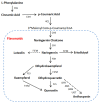Antioxidant Metabolites in Primitive, Wild, and Cultivated Citrus and Their Role in Stress Tolerance
- PMID: 34641344
- PMCID: PMC8510114
- DOI: 10.3390/molecules26195801
Antioxidant Metabolites in Primitive, Wild, and Cultivated Citrus and Their Role in Stress Tolerance
Abstract
The genus Citrus contains a vast range of antioxidant metabolites, dietary metabolites, and antioxidant polyphenols that protect plants from unfavorable environmental conditions, enhance their tolerance to abiotic and biotic stresses, and possess multiple health-promoting effects in humans. This review summarizes various antioxidant metabolites such as organic acids, amino acids, alkaloids, fatty acids, carotenoids, ascorbic acid, tocopherols, terpenoids, hydroxycinnamic acids, flavonoids, and anthocyanins that are distributed in different citrus species. Among these antioxidant metabolites, flavonoids are abundantly present in primitive, wild, and cultivated citrus species and possess the highest antioxidant activity. We demonstrate that the primitive and wild citrus species (e.g., Atalantia buxifolia and C. latipes) have a high level of antioxidant metabolites and are tolerant to various abiotic and biotic stresses compared with cultivated citrus species (e.g., C. sinensis and C. reticulata). Additionally, we highlight the potential usage of citrus wastes (rag, seeds, fruit peels, etc.) and the health-promoting properties of citrus metabolites. Furthermore, we summarize the genes that are involved in the biosynthesis of antioxidant metabolites in different citrus species. We speculate that the genome-engineering technologies should be used to confirm the functions of candidate genes that are responsible for the accumulation of antioxidant metabolites, which will serve as an alternative tool to breed citrus cultivars with increased antioxidant metabolites.
Keywords: antioxidant metabolites; citrus; flavonoids; stress tolerance.
Conflict of interest statement
The authors declare no conflict of interest.
Figures




Similar articles
-
Targeted/untargeted metabolomics and antioxidant properties distinguish Citrus reticulata 'Chachi' from Citrus reticulata Blanco.Food Chem. 2025 Jan 1;462:140806. doi: 10.1016/j.foodchem.2024.140806. Epub 2024 Aug 8. Food Chem. 2025. PMID: 39241684
-
Phenolics, flavonoids and antioxidant capacities in Citrus species with different degree of tolerance to Huanglongbing.Plant Signal Behav. 2020 May 3;15(5):1752447. doi: 10.1080/15592324.2020.1752447. Epub 2020 Apr 14. Plant Signal Behav. 2020. PMID: 32290763 Free PMC article.
-
Antioxidant Capacity, Anticancer Ability and Flavonoids Composition of 35 Citrus (Citrus reticulata Blanco) Varieties.Molecules. 2017 Jul 5;22(7):1114. doi: 10.3390/molecules22071114. Molecules. 2017. PMID: 28678176 Free PMC article.
-
Citrus flavonoids and their antioxidant evaluation.Crit Rev Food Sci Nutr. 2022;62(14):3833-3854. doi: 10.1080/10408398.2020.1870035. Epub 2021 Jan 12. Crit Rev Food Sci Nutr. 2022. PMID: 33435726 Review.
-
Vitamin C and the role of citrus juices as functional food.Nat Prod Commun. 2009 May;4(5):677-700. Nat Prod Commun. 2009. PMID: 19445318 Review.
Cited by
-
Transcriptomic and Widely Targeted Metabolomic Approach Identified Diverse Group of Bioactive Compounds, Antiradical Activities, and Their Associated Genes in Six Sugarcane Varieties.Antioxidants (Basel). 2022 Jul 4;11(7):1319. doi: 10.3390/antiox11071319. Antioxidants (Basel). 2022. PMID: 35883810 Free PMC article.
-
Novel Insights into Anthocyanin Metabolism and Molecular Characterization of Associated Genes in Sugarcane Rinds Using the Metabolome and Transcriptome.Int J Mol Sci. 2021 Dec 29;23(1):338. doi: 10.3390/ijms23010338. Int J Mol Sci. 2021. PMID: 35008763 Free PMC article.
-
Anabolic metabolism of autotoxic substance coumarins in plants.PeerJ. 2023 Dec 6;11:e16508. doi: 10.7717/peerj.16508. eCollection 2023. PeerJ. 2023. PMID: 38077428 Free PMC article. Review.
-
Comparative Analysis of the Chalcone-Flavanone Isomerase Genes in Six Citrus Species and Their Expression Analysis in Sweet Orange (Citrus sinensis).Front Genet. 2022 Apr 12;13:848141. doi: 10.3389/fgene.2022.848141. eCollection 2022. Front Genet. 2022. PMID: 35495138 Free PMC article.
-
Elucidating the Phytochemical Landscape of Leaves, Stems, and Tubers of Codonopsis convolvulacea through Integrated Metabolomics.Molecules. 2024 Jul 4;29(13):3193. doi: 10.3390/molecules29133193. Molecules. 2024. PMID: 38999145 Free PMC article.
References
-
- Liu Y., Heying E., Tanumihardjo S.A. History, global distribution, and nutritional importance of citrus fruits. Compr. Rev. Food Sci. Food Saf. 2012;11:530–545. doi: 10.1111/j.1541-4337.2012.00201.x. - DOI
-
- Hussain S.Z., Naseer B., Qadri T., Fatima T., Bhat T.A. Fruits Grown in Highland Regions of the Himalayas. Springer; Cham, Switzerland: 2021. Citrus Fruits—Morphology, Taxonomy, Composition and Health Benefits; pp. 229–244. - DOI
-
- Al-snafi A.E. Nutritional value and pharmacological importance of citrus species grown in Iraq. IOSR J. Pharm. 2016;6:76–108. doi: 10.9790/3013-0680176108. - DOI
-
- Dala Paula B.M., Raithore S., Manthey J.A., Baldwin E.A., Bai J., Zhao W., Glória M.B.A., Plotto A. Active taste compounds in juice from oranges symptomatic for Huanglongbing (HLB) citrus greening disease. LWT—Food Sci. Technol. 2018;91:518–525. doi: 10.1016/j.lwt.2018.01.083. - DOI
-
- Marhuenda J., Cerdá B., Villaño D., Galindo A., Zafrilla P. Citrus–Health Benefits and Production Technology. Intechopen; London, UK: 2018. Citrus and health; pp. 1–17. - DOI
Publication types
MeSH terms
Substances
Grants and funding
LinkOut - more resources
Full Text Sources
Medical

